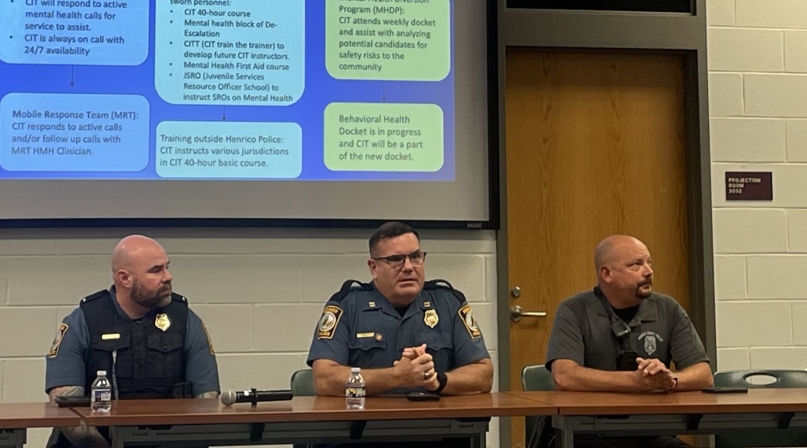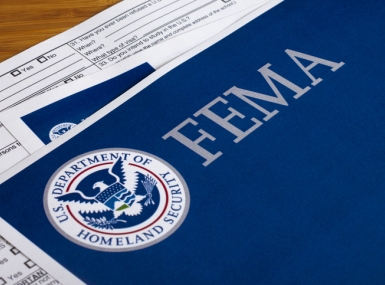Law enforcement, mental health pros collaborate in Virginia county

Key Takeaways
Henrico County, Va.’s crisis response continuum brings together law enforcement and behavioral health professionals to de-escalate mental health crises and avoid unnecessary incarcerations and hospitalizations.
The county’s Services to Aid Recovery (STAR) team is a joint effort among law enforcement, fire, sheriff, social services, schools, local hospitals and mental health providers that serves the county’s most vulnerable population, the people who are in that “revolving door” of crisis and are often placing significant demands on public safety, according to A. Ruby, Henrico County Police Division’s prevention services officer.
As part of the county’s crisis response continuum, law enforcement officers undergo crisis intervention team (CIT) training, which is 40 hours of training on de-escalation and how to effectively respond in a crisis, bringing together first responders, mental health and substance abuse systems and mental health advocacy groups.
“We were missing the mark with our mental health calls and concerns and brought all of our teams in as equal partners,” said Salvatore Mulé, Henrico County Police Division’s community services captain. “It was really a redevelopment of the standard national training methodology … A lot of what drives our prevention services methodology is calls for service.
“We knew early on, if we did [crisis intervention training] right, it would kind of be the ‘Field of Dreams’ effect — ‘if we build it, they will come.’ And we’ve definitely seen that.”
The STAR team meets weekly to identify people who often need crisis help and are likely to need it again. They add these individuals to a shared database, so they can regularly check in and connect them with the right support, noted SB Shapiro Jr., Henrico County Police Division’s prevention services unit lieutenant.
“We’re more efficient,” Mulé said. “Because we’re getting them the resources on the front end, instead of always at the ER.”
Through STAR, the county established a mobile response team to create touchpoints between the team and high utilizers of 911, who might otherwise fall through the system and not get help, according to Alysa Morgan, manager of Henrico County Department of Emergency Communications. Callers may clearly have mental health needs, but aren’t recognizing that themselves, and that’s where the mobile response team comes in, she noted. The mobile response team has three peer specialists, one of whom specializes in working with veterans.
“They may be calling, because someone’s breaking into their attic every night, and they want help with that,” Morgan said. “They don’t want mental health [support], but someone’s not really breaking into their attic, so this team would go out and see individuals and try to engage them in services.
“We played the long game of engagement, of going out and if they needed food, we’d bring them food. If they didn’t have [air conditioning], people actually took money out of their pocket and would get them fans or a window unit or something like that, and built the trust so that they could see that policemen and mental health were working together to help them, and they’d be much more trusting to come in and get services.”
After an individual experiences a mental health crisis, the STAR team helps ensure that they have longer-term support, including having access to medication and assistance with housing and employment, Ruby said.
The team continues to see an increase in mental health calls, which Mulé said he attributes to people knowing they’ll be treated with dignity and respect and providing the “least traumatic avenue” for crisis response.
Henrico County has also implemented the Marcus Alert System, which diminishes the role of law enforcement in behavioral health emergency response, shifting the primary crisis response to behavioral health professionals. The system establishes coordination between 911 and regional crisis call centers to provide response during crisis and puts law enforcement through specialized training for handling a behavioral health crisis.
In Virginia, 67% of people live in localities that have implemented the system, which was created in response to the death of Marcus-David Peters, a young teacher who was fatally shot amid a mental health crisis by a Richmond Police officer in 2018. By 2028, the entire state will have implemented it, according to Hannah Neukrug, Marcus Alert coordinator for Region 4, home to Henrico County. The system has a triage framework that puts calls into four categories, based on urgency: Routine, moderate, urgent and emergency.
For a routine call (in which there may be suicidal thoughts, but no plan and/or means and no homicidal intent or behaviors), the 911 Public Safety Answering Point will refer to 988 regional call centers, where a trained behavioral health professional will speak to the individual and provide referrals to services within 72 hours.
In the case of a moderate call (where there may be minor self-injurious behavior, but no suicide plan or direct access to lethal weapons), in-person behavioral health support is deployed.
If a call is categorized as urgent (where there’s active self-injurious behavior, such as cutting, with concern for medical risk, homicidal thoughts with no active behaviors or intent and suicidal thoughts with access to lethal weapons), a magistrate-issued emergency order is put in place, if available and requested by law enforcement.
The highest level of urgency for a 911 call, in which there’s a direct immediate threat to life, law enforcement, EMS and/or fire staff are deployed without delay and an emergency custody order is issued.
To determine the framework for each category of urgency and how the crisis intervention tools might be integrated into existing procedures, Henrico County convened stakeholders, including police, fire, EMS, the sheriff’s department and mental health professionals, according to Sarah Gray, program manager for Henrico County Mental Health and Developmental Services’ emergency services.
“We had to get our heads around how we were going to implement that 911 triage framework, how we would change our processes and procedures and train our people,” Gray said. “… We wanted to make sure that we trained everybody who touched a console, whether they answered a phone, whether they dispatched.”
Roughly 76% of the county’s crisis responses are resolved in the community, without need for hospitalization or arrest, according to Gray.
“Our goals are basically to de-escalate, to provide the best service that we can in the least restrictive setting to individuals, get them linked to services and help them get where they need to go, and that can look a lot different for each individual,” Gray said.
“… Really the strong foundation I think that we have here is our long partnerships together, with all the different agencies and all of us. Instead of pointing fingers, that ‘It’s your issue,’ it’s all of our issues, and how are we going to help this individual?”
Related News

States file lawsuit challenging FEMA’s new rules on emergency management grants
On November 4, a coalition of 12 states filed a lawsuit against the U.S. Department of Homeland Security (DHS) and the Federal Emergency Management Agency (FEMA), alleging that recent changes to key emergency management grants are unlawful and could disrupt state and local preparedness efforts.

County Countdown – Nov. 4, 2025
Every other week, NACo's County Countdown reviews top federal policy advocacy items with an eye towards counties and the intergovernmental partnership.

